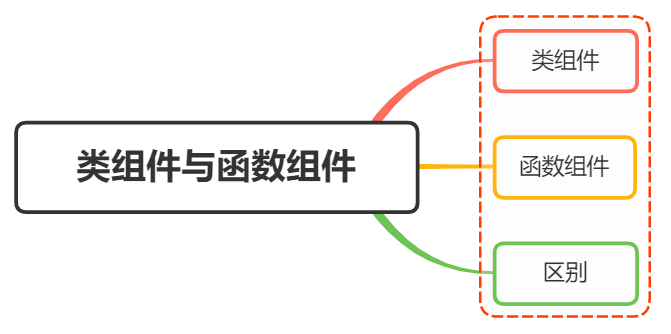面试官:说说对React中类组件和函数组件的理解?有什么区别?

一、类组件
类组件,顾名思义,也就是通过使用ES6类的编写形式去编写组件,该类必须继承React.Component
如果想要访问父组件传递过来的参数,可通过this.props的方式去访问
在组件中必须实现render方法,在return中返回React对象,如下:
class Welcome extends React.Component {
constructor(props) {
super(props)
}
render() {
return <h1>Hello, {this.props.name}</h1>
}
}class Welcome extends React.Component {
constructor(props) {
super(props)
}
render() {
return <h1>Hello, {this.props.name}</h1>
}
}二、函数组件
函数组件,顾名思义,就是通过函数编写的形式去实现一个React组件,是React中定义组件最简单的方式
function Welcome(props) {
return <h1>Hello, {props.name}</h1>;
}function Welcome(props) {
return <h1>Hello, {props.name}</h1>;
}函数第一个参数为props用于接收父组件传递过来的参数
三、区别
针对两种React组件,其区别主要分成以下几大方向:
编写形式
状态管理
生命周期
调用方式
获取渲染的值
编写形式
两者最明显的区别在于编写形式的不同,同一种功能的实现可以分别对应类组件和函数组件的编写形式
函数组件:
function Welcome(props) {
return <h1>Hello, {props.name}</h1>;
}function Welcome(props) {
return <h1>Hello, {props.name}</h1>;
}类组件:
class Welcome extends React.Component {
constructor(props) {
super(props)
}
render() {
return <h1>Hello, {this.props.name}</h1>
}
}class Welcome extends React.Component {
constructor(props) {
super(props)
}
render() {
return <h1>Hello, {this.props.name}</h1>
}
}状态管理
在hooks出来之前,函数组件就是无状态组件,不能保管组件的状态,不像类组件中调用setState
如果想要管理state状态,可以使用useState,如下:
const FunctionalComponent = () => {
const [count, setCount] = React.useState(0);
return (
<div>
<p>count: {count}</p >
<button onClick={() => setCount(count + 1)}>Click</button>
</div>
);
};const FunctionalComponent = () => {
const [count, setCount] = React.useState(0);
return (
<div>
<p>count: {count}</p >
<button onClick={() => setCount(count + 1)}>Click</button>
</div>
);
};在使用hooks情况下,一般如果函数组件调用state,则需要创建一个类组件或者state提升到你的父组件中,然后通过props对象传递到子组件
生命周期
在函数组件中,并不存在生命周期,这是因为这些生命周期钩子都来自于继承的React.Component
所以,如果用到生命周期,就只能使用类组件
但是函数组件使用useEffect也能够完成替代生命周期的作用,这里给出一个简单的例子:
const FunctionalComponent = () => {
useEffect(() => {
console.log("Hello");
}, []);
return <h1>Hello, World</h1>;
};const FunctionalComponent = () => {
useEffect(() => {
console.log("Hello");
}, []);
return <h1>Hello, World</h1>;
};上述简单的例子对应类组件中的componentDidMount生命周期
如果在useEffect回调函数中return 一个函数,则return函数会在组件卸载的时候执行,正如componentWillUnmount
const FunctionalComponent = () => {
React.useEffect(() => {
return () => {
console.log("Bye");
};
}, []);
return <h1>Bye, World</h1>;
};const FunctionalComponent = () => {
React.useEffect(() => {
return () => {
console.log("Bye");
};
}, []);
return <h1>Bye, World</h1>;
};调用方式
如果是一个函数组件,调用则是执行函数即可:
// 你的代码
function SayHi() {
return <p>Hello, React</p >
}
// React内部
const result = SayHi(props) // » <p>Hello, React</p >// 你的代码
function SayHi() {
return <p>Hello, React</p >
}
// React内部
const result = SayHi(props) // » <p>Hello, React</p >如果是一个类组件,则需要将组件进行实例化,然后调用实例对象的render方法:
// 你的代码
class SayHi extends React.Component {
render() {
return <p>Hello, React</p >
}
}
// React内部
const instance = new SayHi(props) // » SayHi {}
const result = instance.render() // » <p>Hello, React</p >// 你的代码
class SayHi extends React.Component {
render() {
return <p>Hello, React</p >
}
}
// React内部
const instance = new SayHi(props) // » SayHi {}
const result = instance.render() // » <p>Hello, React</p >获取渲染的值
首先给出一个示例
函数组件对应如下:
function ProfilePage(props) {
const showMessage = () => {
alert('Followed ' + props.user);
}
const handleClick = () => {
setTimeout(showMessage, 3000);
}
return (
<button onClick={handleClick}>Follow</button>
)
}function ProfilePage(props) {
const showMessage = () => {
alert('Followed ' + props.user);
}
const handleClick = () => {
setTimeout(showMessage, 3000);
}
return (
<button onClick={handleClick}>Follow</button>
)
}类组件对应如下:
class ProfilePage extends React.Component {
showMessage() {
alert('Followed ' + this.props.user);
}
handleClick() {
setTimeout(this.showMessage.bind(this), 3000);
}
render() {
return <button onClick={this.handleClick.bind(this)}>Follow</button>
}
}class ProfilePage extends React.Component {
showMessage() {
alert('Followed ' + this.props.user);
}
handleClick() {
setTimeout(this.showMessage.bind(this), 3000);
}
render() {
return <button onClick={this.handleClick.bind(this)}>Follow</button>
}
}两者看起来实现功能是一致的,但是在类组件中,输出this.props.user,Props 在 React 中是不可变的所以它永远不会改变,但是 this 总是可变的,以便您可以在 render 和生命周期函数中读取新版本
因此,如果我们的组件在请求运行时更新。this.props 将会改变。showMessage 方法从“最新”的 props 中读取 user
而函数组件,本身就不存在this,props并不发生改变,因此同样是点击,alert的内容仍旧是之前的内容
小结
两种组件都有各自的优缺点
函数组件语法更短、更简单,这使得它更容易开发、理解和测试
而类组件也会因大量使用 this 而让人感到困惑